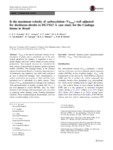Use este identificador para citar ou linkar para este item:
http://www.alice.cnptia.embrapa.br/alice/handle/doc/1053970Registro completo de metadados
| Campo DC | Valor | Idioma |
|---|---|---|
| dc.contributor.author | REZENDE, L. F. C. | pt_BR |
| dc.contributor.author | ARENQUE, B. C. | pt_BR |
| dc.contributor.author | AIDAR, S. de T. | pt_BR |
| dc.contributor.author | MOURA, M. S. B. de | pt_BR |
| dc.contributor.author | RANDOW, C. V. | pt_BR |
| dc.contributor.author | TOURIGNY, E. | pt_BR |
| dc.contributor.author | MENEZES, R. S. C. | pt_BR |
| dc.contributor.author | OMETTO, J. P. H. B. | pt_BR |
| dc.date.accessioned | 2016-10-03T11:11:11Z | pt_BR |
| dc.date.available | 2016-10-03T11:11:11Z | pt_BR |
| dc.date.created | 2016-10-03 | pt_BR |
| dc.date.issued | 2016 | pt_BR |
| dc.identifier.citation | Modeling Earth Systems and Environment, v. 2, p. 42-47, 2016. | pt_BR |
| dc.identifier.uri | http://www.alice.cnptia.embrapa.br/alice/handle/doc/1053970 | pt_BR |
| dc.description | Vcmax is the rate of maximum velocity of carboxylation of plants and is considered one of the most critical parameters for changes in vegetation in face of global changes and it has a direct impact on gross primary productivity. Physiological processes are considered the main sources of uncertainties in dynamic global vegetation models (DGVMs). The Caatinga biome, in the semiarid region of northeastern Brazil, is extremely important due to its biodiversity and endemism. In a field work realized in an area of preserved Caatinga forest, measurements of carbon assimilation (in response to light and CO2) were performed on 11 individuals of a native species. These results of Vcmax measurements in Caatinga were compared with parameterization of models, revealing that Vcmax is not well adjusted in several DGVMs. Also, the values obtained in the Caatinga field experiments were very close to empirical values obtained in the Northern hemisphere (Austria). These ecophysiological measurements can contribute in understanding of this biome | pt_BR |
| dc.language.iso | eng | eng |
| dc.rights | openAccess | eng |
| dc.subject | Bioma Caatinga | pt_BR |
| dc.subject | Dynamic global vegetation models | pt_BR |
| dc.subject | Planta nativa | pt_BR |
| dc.subject | Plant functional types | pt_BR |
| dc.title | Is the maximum velocity of carboxylation (Vcmax) well adjusted for deciduous shrubs in DGVMs: a case study for the Caatinga Biome in Brazil. | pt_BR |
| dc.type | Artigo de periódico | pt_BR |
| dc.date.updated | 2017-01-23T11:11:11Z | pt_BR |
| dc.subject.thesagro | Recurso natural | pt_BR |
| dc.subject.thesagro | Caatinga | pt_BR |
| dc.subject.thesagro | Vegetação | pt_BR |
| riaa.ainfo.id | 1053970 | pt_BR |
| riaa.ainfo.lastupdate | 2017-01-23 | pt_BR |
| dc.identifier.doi | 10.1007/s40808-016-0099-5 | pt_BR |
| dc.contributor.institution | L. F. C. REZENDE, INPE; B. C. ARENQUE, USP; SAULO DE TARSO AIDAR, CPATSA; MAGNA SOELMA BESERRA DE MOURA, CPATSA; C. VON RANDOW, INPE; E. TOURIGNY, INPE; R. S. C. MENEZES, UFPE; J. P. H. B. OMETTO, INPE. | pt_BR |
| Aparece nas coleções: | Artigo em periódico indexado (CPATSA)  | |
Arquivos associados a este item:
| Arquivo | Descrição | Tamanho | Formato | |
|---|---|---|---|---|
| Magna2.pdf | 786,95 kB | Adobe PDF |  Visualizar/Abrir |









